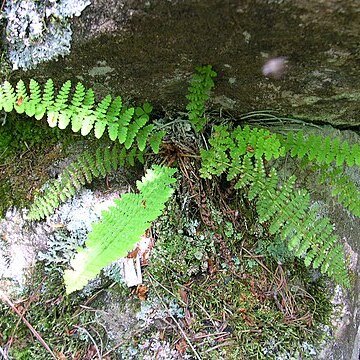Leaves monomorphic, green through winter, 6--40 × 1--6 cm, old leaves persistent as gray or brown conspicuous clump at plant base (only in this species). Petiole 1/3 length of leaf, scaly throughout; scales dense, brown to red-brown. Blades green, linear-lanceolate, pinnate-pinnatifid to 2-pinnate, papery, densely scaly (only in this species) abaxially, glandular, aromatic when handled (only in this species). Pinnae ± in plane of blade, linear-oblong; basal pinnae linear-oblong, much reduced, basal pinnules longer than adjacent pinnules, basal basiscopic pinnule and basal acroscopic pinnule equal; pinnule margins crenately toothed. Sori midway between midvein and margin of segments. Indusia glandular. 2 n = 82.
Plants Woodsia-like in aspect; rhizomes ± erect; lvs evergreen (and long-persistent after death), firm, fragrant, glandular and scaly; petiole short, to 7 cm; blade lance-linear, pinnate-pinnatifid, to 30 × 5.5 cm, acuminate, gradually narrowed below, the lowest pinnae very small; pinnae numerous and crowded, mostly 15–25 pairs, linear-oblong, to 27 × 8 mm, with 6–10 pairs of oblong, obtuse, crenate segments to 5 mm, not spinulose; veins obscure, 2–3 pairs per segment; sori large, often only 1–4 per segment; indusia glandular-margined; 2n=82. Cliff-crevices, often on limestone; interruptedly circumboreal, s. to N. Y., Ont., n. Mich., Wis., and Minn.
A fern. It grows 20-30 cm tall. The blade is oblong to sword shaped and 10-25 cm long by 2-4 cm wide.

